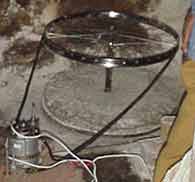Historically Waterwheels (aka watermills, water wheels) have been used to extract power from flowing water and convert it into mechanical power for turning grinding stones and other machinery. Although waterwheels have now died out of use across most of the world thanks to national grid electricity, they are still in common use off-grid in places such as Nepal and India where hundreds of thousands of waterwheels are still used to this day.
For many in the Himalayan regions a water wheel is the only source of power, together with dangerous kerosene lamps. Now people are looking at ways in which waterwheels can be used to generated electricity, not just for these remote regions, but also in Europe and North America where enormous energy resources are untapped at present.
In developing countries where water wheel power is common, electricity can be generated for those people who live where the electricity grid cannot reach, and combined with modern energy efficient LED and CFT lighting, can improve their standard of living enormously. It is not complicated or expensive to modifyan existing waterwheel driven mill to operate as an electricity generator.

Pictured above is one example of how simply a water power can be used to generate electricity. An old bicycle wheel transmits the rotation of the waterwheel through a v-style car belt to an old car alternator. If the watermill turns at around 60rpm, the alternator is made to turn at hundreds of rpm, (thanks to a pulley ratio of 10+ to 1) and so the voltage generated (14.4 VDC) is perfect for recharging 12V batteries. Car alternators can supply hundreds of watts of electrical power which can then be used to power lighting, radios, computers and so on. The typical cost of such a system is just 3-4,000 Indian Rupees (< £35), and has the advantage that the waterwheels used to generate power has been and can continue to be maintained by the mill owner as it has been for centuries. To find out more about this fascinating use of waterwheels, please click here: Nepal Ghatta Project
Hydro-power idea for county river – A group are looking to restore and use 100 old waterwheels on the River Lugg in Hereford/Worcestershire.
Hesco are currently developing a conversion kit for watermills to tap into the 2.5 Gigawatts of power in the 200,000 Himalyan watermills. Visit their website to find out the approaches they are using to modify waterwheels.
The Development of Traditional Himalayan Watermills for Sustainable Village Scale Micro-Hydropower